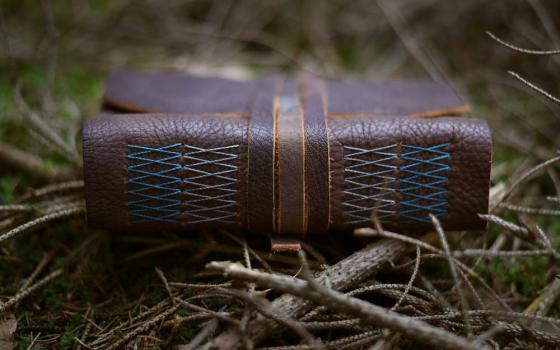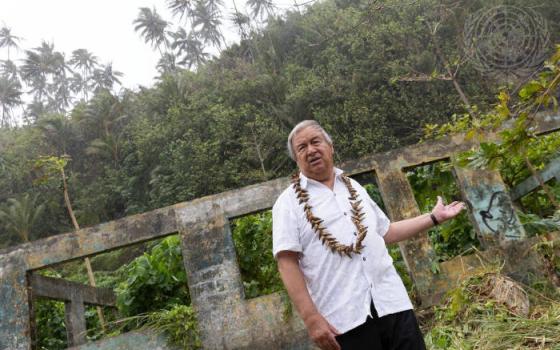(YouTube/UISG)
Editor's note: This story originally appeared at Knowable Magazine and is republished here as part of Covering Climate Now, a global journalism collaboration strengthening coverage of the climate story.
California's 2020 fires were unprecedented — and not just because they covered more than 4 million acres.
The Creek Fire, which burned east of Fresno in the western Sierra Nevada, flamed with such frenzy that it produced a cloud resembling an atomic bomb blast, with smoke reaching the stratosphere. That fire and others, like the huge, lightning-sparked North Complex fires in the Sierras north of Sacramento, didn't burn in the usual patchy fashion of wildfires, leaving lightly singed spots mixed with more intensely burned islands. They torched much of the acreage within their boundaries, killing even large trees that would have withstood smaller blazes.

The resulting charred landscapes, a consequence of decades of fire suppression policies and a warming climate, may represent a funeral for some forests, which struggle to regenerate on their own after such severe conflagrations. This new regime of ferocious flames threatens to completely change familiar forest ecosystems, tipping towering pine stands into lands dominated by squat scrub species. Forest ecologists warn that this may harm biodiversity, lower the capacity of forests to store carbon and even threaten water supplies.
That's why researchers are working to refine how to restore areas that have been heavily burned. It's why many land managers are rethinking traditional restoration approaches with a view to future-proofing. As regions grow warmer and drier with the changing climate, trees that once thrived at a given site might not be suited for that site in future decades. So ecologists and foresters are turning to clues from the scars of earlier destructive fires to figure out what restoration approaches would work best, and exploring new methods of sourcing seeds. The results may hold broad lessons on how to rebuild forests across the western U.S. so they can withstand a hotter and drier future.
Friendly fire
Many ecosystems in California and the West are adapted to, and sometimes even require, frequent fires. This includes the conifers of the Sierras, the shrubby chaparral of coastal and inland climes, and the oak savannahs of foothill zones. Historically, both lightning and Native Americans sparked regular blazes. For Indigenous peoples, fire aided in the cultivation and management of the land.
Those forest fires mostly burned through dry brush and lower vegetation, helping a diversity of plants to establish, returning nutrients to the soil and maintaining mountain meadows by preventing pines from encroaching. But today's fires tend to include large patches of fierce crown fires, in which flames engulf the entire forest canopy.
These intense fires kill trees across broad areas, and the scorched expanses are too large for nearby surviving trees to reseed. As with apples, the cone does not fall far from the pine: Among foresters, the general rule is that seeds can move a maximum distance that's twice the height of the mother tree. "The seeds of the conifer trees are too heavy to disperse out into that area," says Matthew Hurteau, a forest ecologist at the University of New Mexico. "And then the other thing is, when you burn off all the tree cover, it gets a hell of a lot hotter and drier in that environment." That means the seeds that do sprout may have trouble surviving.
A man in Houston has his nose swabbed for coronavirus July 7. (CNS/Reuters/Callaghan O'Hare)
Without intervention, a tangle of fast-growing shrubs — Ceanothus species and manzanita among them — crawl into the cleared space, forming a dense cover that young trees have trouble competing with. This accelerates another process driven by climate change: the expansion of shrub ecosystems as the cool climate favorable for forests gradually moves upslope.
When high-severity fires kill big sections of forest, they also harm biodiversity and habitat for numerous species. Large, intensely burned areas and the shrub cover that follows lack the varied habitat niches the forest would normally provide, and therefore have reduced biodiversity, says Malcolm North, an ecologist with the University of California, Davis. Sensitive animal species like the spotted owl and weasel-like Pacific fisher need fragments of dense forest.
Broad, post-fire shrub patches are dominated by just a handful of plant species, adds Wolfy Rougle, forest health watershed coordinator of the Butte County resource conservation district on the western slope of the Sierra Nevada. And while deer and elk may munch on the young sprouts and grasses that grow after a fire, once the dense thicket forms, there's little for them to eat.
When tall pines give way to scrubby chaparral, important ecosystem processes are also lost or diminished. In these times of rising atmospheric carbon dioxide, we need all the carbon storage we can get, but shrublands don't do that nearly as well. "Shrubs hold maybe 5 to 8 percent of the carbon that a forest might — it's a dramatic drop," North says.
All this means that foresters may need to replant saplings after severe burns such as those California experienced this year — and that need has been growing as megafires become more common. The acreage that must be replanted annually is now several times more than it was in the 1970s, North estimates.
But replanting isn't as simple as it sounds: Trees in California are often highly adapted to their particular elevation, aspect and soil type. Some people might roll their eyes at yet another claim that the Golden State is special, but in this case it's true. In other parts of the country, deglaciation occurred relatively recently: The Great Lakes ecosystem emerged from being covered in glaciers only 12,000 years ago, for example. The region now known as California, however, was never fully glaciated, so its flora has had hundreds of thousands, if not millions, of years to evolve.
That, in addition to the variety of geologic landforms within the state, helped give rise to extraordinary biodiversity, says Bruce Baldwin, an evolutionary biologist at the University of California, Berkeley, who authored a review of the state's exceptional plant diversity in the Annual Review of Ecology, Evolution, and Systematics.
Take the prickly coned Pacific ponderosa pine, which dominates many lower mountain slopes from southern British Columbia to San Diego. On the west slope of the Sierras in northern California, the pines enjoy an annual rainfall of 69 inches, but they can also thrive on the drier eastern slopes. All the trees are of one species, but each population can be so specialized to its particular niche that a seed planted in a spot with different rainfall, soils or temperature will often do poorly.
The clearest evidence for such specialization comes from experiments called provenance tests that were done starting in the 1930s, in which researchers planted tree seeds at various elevations. The general pattern that came out was that plants grew best within about 500 feet up or down from their source. "Anything more than 500 feet was really moving them more than what was optimal," says North.
For that reason, the US Forest Service has a rule of thumb that trees should not be replanted outside their original 500-foot elevation band. The rule is codified in the California tree seed zone map, first published in 1946. It's had a couple of revisions since then, but it's still the document that silviculturists refer to when sourcing their seeds.
Sourcing seeds for the future climate
In their efforts to revegetate with the most local seeds possible, reforestation workers found the 500-foot rule satisfactory — until the impacts of climate change began to reveal themselves. As temperatures warmed, trees' historic habitats sometimes no longer matched their preferred climate. That's making experts think twice about what seeds to plant, says Emily Moran, an ecologist at the University of California, Merced. "There's been a lot more interest in trying to find what are actually the seed sources we want to be planting — to make sure that the areas we're restoring are going to be healthy in the future," she says.
In 2019, Moran published a study showing this for oak and conifer seedlings in Yosemite and Sequoia national parks. Her team studied data from 25 forest plots, ranging from lower-elevation oak and mixed conifer forest, to red fir, to higher-elevation white pine stands, to see how climate affected rates of tree growth and survival. Over the course of a decade, increasing July maximum temperatures were linked to diminished survival and growth in most species, the scientists found. Midsize oak seedlings, for example, saw their odds of surviving through a given year drop from 95 percent to 80 percent with hotter summer temperatures.
Advertisement
But it's one thing to acknowledge that trees in the future will face challenges with climate change. It's much harder to figure out exactly how to plant resilient forests. If land managers decide that they indeed need to plant varieties better adapted for conditions in the coming decades, which future emissions scenario should they choose? Depending on the actions (or inaction) of world governments in coming years, there are many possible future climate outcomes. And even if biologists can determine the best seeds to sow for the climate of 2100, those seeds might find today's conditions still too cold to survive.
One way to reforest for a future climate, says Moran, is to source your seeds from a population of the same species at a lower elevation or latitude, since those trees may be better adapted to warmer temperatures. A 2018 Forest Service article explored whether foresters should do just that: move seeds uphill to higher elevation bands — crossing the traditional boundary.
Some foresters working to restore burned areas have already taken up that advice. In Butte County, hundreds of thousands of acres burned in this year's North Complex Fire and the 2018 Camp Fire — and to heal the scars, agencies, timber companies and local officials are working on plans to reforest with the changing climate in mind. "There were native pines and cedar there before the fire, but with climate change there aren't going to be as many conifers," says Rougle. "I think most managers are realizing now, if you do reforest after a high severity burn, you're not necessarily going to reforest with the same species mix."
Instead, the plan for the burned region, largely located at lower mountain elevations below 4,000 feet, will include a mix of measures: thinning and burning back shrubs to help oaks naturally resprout; replanting some areas with a seed mixture with more hardwoods and fewer conifers than were there before; and sourcing seeds from lower elevations. It may be a bit of a gamble, but with climate change looming it may be riskier to just plant the same trees again, Rougle says. "We need to have the humility to try a few different things."
An emergency vehicle drives past the wind-driven Bond Fire wildfire near Lake Irvine, California, Dec. 3. (CNS/Mike Blake, Reuters)
A simple elevation shift might overlook some subtleties, though. While scientists can anticipate how climate change will affect larger regions, predicting the fate of a given 100-acre forest plot can be trickier. Moran is dealing with this nuance at her experiment in the scar of the 2014 King Fire, located in Eldorado National Forest east of Sacramento. "When looking at how this planting environment has changed over the last century, it's not actually what one might think," she says. Winters are warmer now, but summers are slightly cooler. The site's gotten more precipitation in recent years, but the snow that falls melts faster. Knowing which trees will do best here is not straightforward.
So scientists are also using genetic analysis to understand on a more granular level which traits enable a tree to cope with future drought or heat. A gene variant might, for example, result in trees having more roots in proportion to shoots, which means they can draw more water while limiting moisture loss from leaves. Once they've identified individuals with traits like this, researchers can study saplings in test environments to see how well they do.
Moran is testing both of these approaches at her King Fire experiment. In collaboration with research geneticist Jessica Wright of the Forest Service's Pacific Southwest Research Station, she's leading a project tracking the survival and growth of more than 3,000 ponderosa and sugar pines replanted in three sites scorched by the fire, using seeds from similar elevation as well as seeds from lower elevation bands. The pair is using DNA extracted from the plants to identify genetic markers that are associated with their home climates.
"My hope is to help inform decisions that will result in more resilient forests," says Wright. If the two can identify genetic variants that help to prime trees for a particular climate, that could allow reforesters to pick seeds best suited for climate change. The first seedlings were planted in 2017, so the experiment has yet to yield published results.
From 'pines in lines' to clumps
But reforestation isn't just about which trees you plant. It also matters how you plant them. With regular, mixed-severity fires, experiments have shown that Sierra Nevada and other western dry forests become patchy, with clumps of 5 to 10 trees scattered around shrub patches and meadows, a pattern visible in historical photos from the nineteenth century. But today's replantings tend to be more uniform — what North refers to as "pines in lines."
North advocates planting a more varied landscape, positioning clusters of trees at spots where more moisture is available. Between the clumps, foresters would plant scattered individual trees and leave meadows and more sparsely planted areas that can act as natural firebreaks. In parts of the King Fire footprint, foresters are starting to do just this, breaking away from the traditional pines-in-lines approach and planting trees in clumps instead.
These methods could help build more resilient forests that burn in patches, rather than all-consuming flames. This, in turn, lets carbon absorbed from the atmosphere through photosynthesis build up in thickening tree limbs, rather than burning off every few years as it would in a shrub-dominated ecosystem.
In some locations, patchier forests can also help snow accumulate. Gabrielle Boisramé, a hydrologist with the Desert Research Institute in Las Vegas, has found that some Sierra forests that have regular smaller wildfires, and therefore a patchier canopy with more clearings, hold more snow than denser nearby stands. This snowpack acts as a slow-release source of water, supplying cities and ecosystems with water through California's dry summer months.
Seeds of change
As foresters, ecologists and plant geneticists refine which seeds to plant to build climate-resilient forests, some scientists urge caution about importing seedlings from elsewhere. Baldwin, the evolutionary biologist, acknowledges that replanters have improved their methods in recent years by more carefully considering their seed sources, but he's skeptical of assisting trees in migrating to cooler elevations. "There's been a lack of appreciation for the potential downsides of some of that activity," he says. He thinks that foresters should import seed only in extreme situations in which the local flora truly can't recover on their own. Since California's diverse flora have had such a long time to evolve, there's a lot of "cryptic diversity" — including potentially unrecognized species — lurking across the landscape, he says.
Failing to recognize this diversity could lead to what's known as outbreeding depression, in which finely tuned genetic adaptations get disrupted when a local plant breeds with one adapted to conditions elsewhere. But though this is a theoretical risk, research on the topic has found it's not a major concern, Moran says. In most cases, foresters are only moving trees up to the next elevation band, which is often within the range of tree-breeding for wind-pollinated species anyway — so the trees just uphill are not genetically distinct.
Plus, as long as a reseeding effort uses both local seeds and those chosen for climate adaptability, young trees that aren't the right fit will be outcompeted while those better suited for survival will reach maturity. Intentionally burning these reforested lands about 15 to 20 years after replanting can also help select for the toughest trees, North notes.
Introducing new trees from populations that aren't next door on the seed map is still taboo among US agencies that oversee public lands. In Moran's experiments in the Sierra and Tahoe national forests and Sequoia National Park — where the planted trees came from all over the state, not just right downhill — officials have required that she return and remove the trees before they fully mature and shed any seeds.
In Canada, however, forest officials have already changed their guidelines such that silviculturists are instructed to pick seeds suitable for a future warmer climate, rather than replanting with local seeds. That includes even shifting the species mix toward tree types better suited to a changing climate.
There may never be a clear answer on the extent to which humans should meddle in the post-fire footprints of forests. Those decisions, after all, involve value judgements about what's most important to managers. Still, though foresters may disagree on the level of meddling that's permissible, they are increasingly being convinced that trees might indeed need human help in order to preserve the benefits that forested ecosystems provide. It may be time to radically rethink reforestation and rebuild forests into ones more resilient to the threats of climate change.
"Trees don't walk, and we are shifting the climate faster than it appears to have shifted in a long time," says North. "It's incumbent on us to start researching and experimenting."
[Ula Chrobak is a freelance science writer. You can find her on Twitter @ulachrobak and check out her website to see more of her work.]





